|
As a process moves from activity to activity, it consumes time, and each
activity adds to the overall duration. But different sorts of activities have
different durations, and it's not uncommon to observe a ten-step process that
outpaces, say, a fi ve-step one. It depends, of course, on what those
activities are doing.
In SOA, process cycle times range from one second or less to one or more years!
The latter sort need not have a large number of activities. The pyramids might
have been built rock-by-rock over several decades, but protracted SOA processes
typically span only a few dozen tasks, a handful of which consume almost the
entire interval.
It's not easy to build an SOA process engine that can simultaneously blaze
through a sub-second process but keep on top of a one that hasn't moved in
weeks. On the other hand, when a long-running process rouses, we expect the
engine to race very quickly to the next milestone. The central argument of this
chapter is that both long-running and short-running processes run in very quick
bursts, but whereas a short-running process runs in a single burst, a
long-running process might have several bursts, separated by long waits. To
support long-running processes, the process engine needs a strategy to keep
state.
In this chapter, we examine the fundamental differences between long-running and
short-running processes. We discuss how to model state, and demonstrate how to
build a long-running process as a combination of several short-running
processes tied together by state. We also show how to compile short-running
BPEL processes to improve the execution speed of a burst.
Process Duration—the Long and Short of It
SOA processes have the following types of activities:
1. Tasks to extract, manipulate, or transform process data
2. Scripts or inline code snippets
3. Calls to systems and services, both synchronous and asynchronous
4. Events, including timed events, callbacks, and unsolicited notifi cations
from systems
The fi rst three sorts of activities execute quickly, the fi rst two in the
order of milliseconds, the third often sub-second but seldom more than a few
seconds (in the case of a synchronous call to a slow system). These activities
are active: as the process navigates through them, it actively performs work,
and in doing so ties up the process engine. Event times are generally much
longer and more variable. Events come from other systems, so (with the
exception of timed events) the process cannot control how quickly they arrive.
The process passively waits for events, in effect going to sleep until they
come.
An event can occur at the beginning of a process—indeed, every SOA process
starts with an event—or in the middle. An event in the middle is called an
intermediate event. The segment of a process between two events is called a
burst. In the following fi gure, events are drawn as circles, activities as
boxes, and bursts as bounding boxes that contain activities. Process (a), for
example, starts with an event and is followed by two activities—Set Data and
Sync Call—which together form a burst. Process (b) starts with an event,
continues with a burst (consisting of the activities Set Data and Call System
Async), proceeds to an intermediate event (Fast Response), and concludes with a
burst containing the activity Sync Call. Process (c) has two intermediate
events and three bursts, and (d) has a single intermediate event and two
bursts.
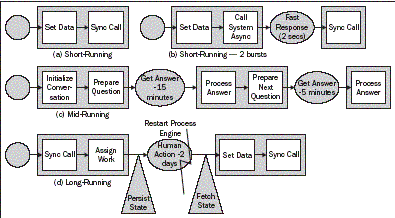
Processes are classifi ed by duration as follows:
-
Short-running:
T he process runs comparatively quickly, for not more than a few seconds. Most
short-running processes run in single burst (as in process (a) in the fi gure),
but some have intermediate events with fast arrival times—as in (b), where the
intermediate event, a response to an asynchronous system call, arrives in about
two seconds—and thus run in multiple bursts. TIBCO's BusinessWorks and the BPEL
compiler described later in the chapter are optimized to run both single-burst
and multiple-burst short-running processes. BEA's Weblogic Integration can run
single-burst, short-running processes with limited overhead, but, as discussed
further next, treats cases like (b) as long-running.
-
Long-running:
T he process has multiple bursts, and the waiting times of its intermediate
events are longer than the process engine itself is expected to run before its
next restart! In process (d), for example, the engine is restarted for
maintenance while the process waits two days for a human action. The process
survives the restart because its state is persisted. At the end of its fi rst
burst (that is, after the Assign Work step), the engine writes the state to a
database, recording the fact that the process is now waiting on an event for a
human action. When the engine comes back up, it fetches the state from the
database to remember where it left off. Most BPEL processes are longrunning. In
Weblogic Integration, stateful processes can run for arbitrarily long
durations.
-
Mid-running: T he process has multiple bursts, but the waiting
times of its intermediate events last no more than a few minutes, and do not
need to be persisted. Stakeholders accept the risk that if the process engine
goes down, in-fl ight processes are lost. Chordiant's Foundation Server uses
mid-running processes to orchestrate the interaction between agent and customer
when the customer dials into a call center. The call is modeled as a
conversation, somewhat like a sequence of questions and answers. A burst, in
this design, processes the previous answer (for example, the Process Answer
activity in (c)) and prepares the next question (Prepare Question).
Intermediate events (Get Answer) wait for the customer to answer. State is held
in memory.
Stateful and Stateless Processes in BEA's Weblogic Integration
I n Weblogic Integration, single-burst processes are stateless, but
multiple-burst processes, even short-running ones, are stateful. Even if the
wait between bursts is very small (one or two seconds perhaps), Weblogic
Integration nonetheless persists process state to a database. The distinction
is subtle, but Weblogic Integration provides visual clues to help us detect the
difference. In the next fi gure, the process on the left is stateless. The
process on the right is the same as that on the left except for the addition of
an event step called Control Receive; the step, in effect, puts the process in
a wait state until it receives a specifi c event. When this step is added,
Weblogic Integration changes the appearance of its start step—Start—from a
circle with a thin border to one with a thick border, indicating that the
process has changed from being stateless to stateful.
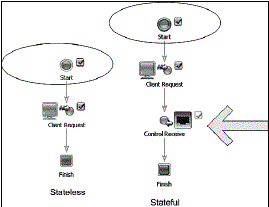
Those who designed Weblogic Integration thought process state so important that
they worked into their notation whether a process is stateful or stateless. We
now study one of the most critical pieces of any process engine: how it keeps
state.
H ow to Keep Long-Running State
In this section, we study the data models for long-running process state in two
commercial process integration platforms: Oracle's BPEL Process Manager and
BEA's Weblogic Integration. We also develop our own model, a generalization of
the Oracle and BEA approaches, which enables us to achieve the effect of a
long-running SOA process from a group of short-running processes. We put this
model to practical use later in this chapter, in the email money transfer
example.
SOA process state models contain information about the following:
-
Process metadata, including the types of processes currently deployed, their
versions, and how their activities are assembled.
-
Process instances, including status, start time and end time, and the position
of the instance in a call graph (that is, parent/child relationships). Some
models also track the status of individual activities.
-
Pending events, and how to correlate them with process instances.
State in Oracle's BPEL Process Manager
Th e following fi gure shows the core tables in the Oracle BPEL model (version
10.1.2).
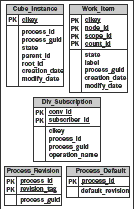
In this model process, metadata is held in two tables: Process_Default and
Process_Revision. The former lists all deployed BPEL processes and their
current revision numbers; the process_id fi eld is not a technical key but the
name of the process specifi ed by the developer. The latter lists all of the
revisions; for a given process, each revision has a distinct GUID, given by the
fi eld process_guid.
The seemingly-misnamed table Cube_Instance—actually, cube is synonymous with
process in the internals of the product—has information about current and
completed process instances. The instance has a unique key, given by cikey.
From process_guid we can deduce, by joining with Process_Revision, the process
type and revision of the instance. Other important information includes the
instance creation date, its parent instance, and its current state. Possible
states are active, aborted, stale, and completed, although the state fi eld
uses numeric codes for these values.
The Work_Item table tracks the status of instance activities. Cikey indicates
the instance to which the activity belongs. Within an instance the activity is
identifi ed by the combination of node_id, scope_id, and count_id. The fi rst
two of these indicate the position of the activity in the process graph and the
scope level to which it belongs; the label column is a friendlier alternative
to these, assuming that the developer applied a useful label to the activity.
Count_id is required in case the activity executes more than once. Work_Item
has its own state fi eld (again numeric), which indicates whether the activity
is completed or pending, was cancelled, or encountered an exception.
Dlv _Subscription records pending events and correlates them with instances.
Conv_id is a conversation identifi er known to both the BPEL process and its
partner service. To trigger the event, the partner service passes this identifi
er as part of its message. The process matches it to a subscriber_id, which
uniquely identifi es the activity that is waiting on the event. Thus, when the
event arrives, the process knows exactly from which point to continue.
(Technically, subscriber_id is a delimited string, which encodes as part of its
structure the values of cikey, node_id, scope_id, and count_id that point to a
unique Work_Item record.) The partner also specifi es an operation name, which
specifi es which type of event it is fi ring. If the process is waiting on
several events in the same conversation (as part of an event pick, also known
as a deferred choice), operation_name determines which path to follow. The
combination of operation_name and conv_id points to a unique activity (that is,
to a unique subscriber_id).
State in BEA's Weblogic Integration
The following fi gure shows three important tables in the Weblogic Integration
model:
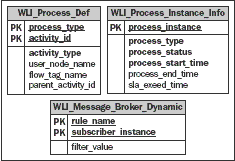
WLI_Process_Def has metadata about types of deployed processes and their
activities. The table has one row for each activity. Process_type is the
human-readable name of a process. Activity_id is the numeric identifi er of an
activity in the process, although user_node_name, the descriptive name provided
by the developer is more intuitive.
Process instance information is held in WLI_Process_Instance_Info. Each instance
has a unique numeric identifi er, given by process_instance. Process_type
specifi es the process defi nition on which the instance is based.
Process_status specifi es, in a numeric code, whether the instance is active,
pending, or aborted. The table also tracks process start and end times, as well
as time in excess of the SLA (sla_exceed_time). Through Weblogic Integration's
administration console, the administrator can confi gure an SLA on process
cycle time.
In Weblogic Integration a process instance can receive intermediate events by
several means. One of the most important of these is by listening for messages
published by Weblogic Integration's message broker system. The table
WLI_Message_Broker_ Dynamic keeps track of specifi c events waiting on broker
messages. The column subscriber_instance is the process instance identifi er;
it matches the process_ instance value in WLI_Process_Instance_Info. Rule_name
is, in effect, a pointer to the event in that instance. Filter_value is an
XQuery expression that checks the content of the message to determine whether
to accept the event. When a message arrives, the broker checks for any
subscription events, and triggers those whose fi lter test passes.
Our Own State Model
Our own model, shown in the next fi gure, follows a design approach similar to
that of the Oracle and BEA models.
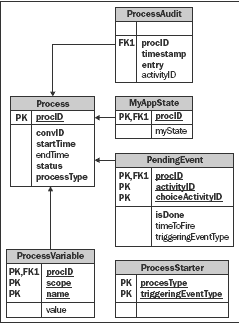
To begin, the model features a single metadata table, called ProcessStarter,
which enumerates the types of processes deployed (processType) and specifi es
for each the type of event that can start it (triggeringEventType). The table's
main purpose is to route start events: when an external event arrives, if
ProcessStarter can map it to a process, then a new instance of that process is
created from the event.
Several tables track the state of process instances. The Process table assigns a
unique identifi er to each instance (procID), indicates its type (processType),
locates it in a conversation (convID), and records its start time, end time,
and status (pending, completed, or aborted). The ProcessVariable table persists
process variables, ensuring that instance-specifi c data survives system
restarts. A variable is identifi ed by a name (name) that is unique within its
level of scope (scope) in a process instance (procID). The ProcessAudit table
keeps a chronological list of important occurrences in a process instance. It
is tied to a specifi c instance (procID), and has both a timestamp and a text
entry. The entry can optionally be associated with a specifi c process activity
(activityID). Implementations can extend the model by providing a custom state
table (such as the hypothetical MyAppState in the diagram) that associates
application-specifi c fi elds (myState, in this example) with an instance.
Final ly, the PendingEvent table assists in correlating intermediate events. An
event is identifi ed by the combination of its process instance (procID), its
activity node in the process (activityID), and if it is part of a deferred
choice, the identity of that choice (choiceActivityID). (If the event is not
part of a choice, choiceActivityID is zero or null.) There are two types of
events: timed events and events triggered by a message. If the event is a timed
event, timeToFire specifi es the date and time (somewhere in the future) when
the event should fi re. If the event is message-based, triggeringEventType
indicates the type of message that triggers it. When the event is created, the
Boolean fi eld isDone is set to false. When the event fi res, isDone is
switched to true. If the event is part of a choice, isDone is set to true for
all events in the choice, thereby ensuring that only one event is chosen.
The model assumes that all messages carry the following fi elds:
-
Event Type
-
Recipient Process Type
-
Conversation ID
When a message arrives, the following logic determines how to route it:
-
If there is an instance of the process in the conversation (that is, if there
are rows in Process where processType and convID match the values from the
message), check whether it has a pending event of the given event type (that
is, check for rows in PendingEvent where procID matches the value from Process,
isDone is false, and triggeringEventType matches the event type). If it does,
fi re the event. Otherwise, discard the event.
-
If there is no instance of the process in the conversation, check whether the
process can be started by this type of event. (That is, check for rows in
ProcessStarter where processType and triggeringEventType match those from the
message.) If so, instantiate the process. Otherwise, discard the event.
Combining Short-Running Processes with State in TIBCO's
BusinessWorks
The next discussion covers the TIBCO implementation of the email transfer
process.
Our Use Case—Sending Money by Email
With this model in place, we build a process that spans several days as a set of
short-running processes, none of which lasts more than a few seconds. In a
transfer there are four main parties: the sender, the sender's bank, the
recipient, and the recipient's bank. We build the process for the sender's
bank.
The following fi gure depicts the required fl ow of events:
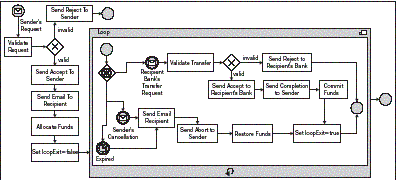
When the bank receives the request to send funds from the sender (Sender's
Request), it validates the request (Validate Request), and rejects it if
discovers a problem (Send Reject to Sender). If the request is valid, the bank
informs the sender of its acceptance (Send Accept to Sender), notifi es the
recipient by email (Send Email To Recipient), and sets aside funds from the
sender's account (Allocate Funds). The fi rst burst is complete, but several
possible paths can follow:
1. There is a time limit on the transfer, and if it expires the transfer is
aborted.
2. The sender may cancel the transfer.
3. The sender's bank may reject the recipient's bank's request to move the
funds into the recipient's account. The recipient may try again later.
4. The sender's bank may accept the recipient's bank's request to move the
funds into the recipient's account.
The co ntrol fl ow to support this logic is a deferred choice inside a loop. The
loop runs for as long as the variable loopExit is false. The process
initializes the value to false (Set loopExit=false) immediately before entering
the loop. Paths 1, 2, and 4 set it to true (Set loopExit=true) when they
complete, signaling that there is no further work to do and the loop need not
make another iteration. Path 3 leaves the loopExit fl ag alone, keeping it as
false, thus allowing another iteration (and another chance to complete the
transfer). Each iteration is a burst.
There are three events in the deferred choice, one for expiry (path 1), one for
cancellation (path 2), and one for the recipient's bank transfer request (paths
3 and 4). The logic for cancellation and expiry (headed by the events Sender's
Cancellation and Expired respectively) is identical: the process sends a
cancellation email to the recipient (Send Email Recipient), informs the sender
that the transfer is aborted (Send Abort to Sender), and restores the funds to
the sender's account (Restore Funds). In the transfer request path (starting
with the event Recipient Bank's Transfer Request), the sender bank validates
the transfer (Validate Transfer) and sends the outcome to the recipient's bank
(Send Reject to Recipient Bank or Send Accept to Recipient Bank). If validation
passes, the process also notifi es the sender that the transfer is complete
(Send Completion to Sender) and commits the funds it had earlier allocated
(Commit Funds).
The sender's bank's process is long-running, typically spanning several days
from start to fi nish. To build it using a short-running process engine, such
as TIBCO's BusinessWorks, we need to break it into smaller processes: one to
handle the sender's request to send funds, one to handle the recipient's bank's
request to complete the transfer, one to handle the sender's cancellation, one
to handle expiry, and one to manage the overall event routing. In dividing the
process into pieces, we lose the loop and deferred choice, but we add
housekeeping responsibility to each piece.
The Router Process
The next fi gure shows the BusinessWorks process to handle the overall routing.
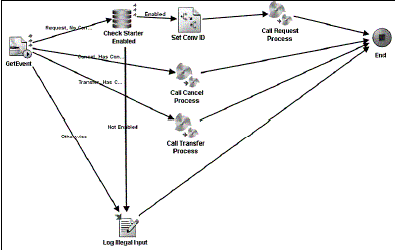
When it receives an inbound message on a JMS queue in GetEvent, the router
process checks the event type to determine to which BusinessWorks process to
route the event. There are three event types:
-
Request:
S ent by the account holder (known as the sender). Because this request starts
the process, it must not contain a conversation identifi er. If it does, the
route process immediately logs the event as an error and discards it (Log
Illegal Input). Otherwise, it queries the ProcessStarter table, in the step
Check Starter Enabled, to verify that the email transfer process may be started
by this type of event. (It checks that there is a record in the table that
matches the given event type and process type.) If this check passes, the route
process creates a unique conversation identifi er (Set Conv ID) and calls the
request process to handle the event (Call Request Process).
-
Transfer:
Sent by the recipient bank. The route process checks that the message has a
conversation identifi er. If it does, it calls the transfer process (Call
Transfer Process) to handle the event. Otherwise, it logs the event and
discards it (Log Illegal Input).
-
Cancel: S ent by the sender or internally by the timer process
(discussed further next). The route process checks that the message has a
conversation identifi er. If it does, it calls the cancellation process (Call
Cancel Process) to handle the event. Otherwise, it logs the event and discards
it (Log Illegal Input).
The Request Process
T he next fi gure shows the BusinessWorks process to handle the sender's request
to send funds:
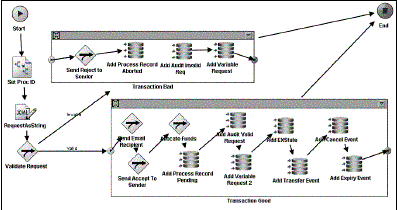
The process begins by creating a unique process identifi er (Set Proc ID) and
then validates the request (Validate Request). If the request is invalid, the
process sends a rejection to the sender (Send Reject to Sender) and writes
three records to the database:
-
A record in the Process table (using Add Process Record Aborted) that sets the
status of the instance to ABORTED. The process identifi er is the one created
in Set Proc ID.
-
A log of the validation failure (using Add Audit Invalid Req) in the
ProcessAudit table.
-
A copy of the inbound message in the ProcessVariable table, using Add Variable
Request. The earlier step RequestAsString converts the message from XML to
string form.
Thus, there is a record that the instance was aborted, an explanation in the
audit trail why it failed, and a copy of its message data.
The happy path, in which the request passes validation, contains three steps
that we described earlier: Send Email Recipient, Send Accept to Sender, and
Allocate Funds. It also creates the following records in the database:
-
A record in the Process table (using Add Process Record Pending) about the
instance, with a status of PENDING and the identifi er created in Set Proc ID.
-
An indication that the validation passed (using Add Audit Valid Request) in the
ProcessAudit table.
-
A copy of the inbound message (using Add Variable Request 2) in the
ProcessVariable table.
-
Three PendingEvent records, for transfer, expiry, and cancel respectively
(using the steps Add Transfer Event, Add Expiry Event, Add Cancel Event). The
records share a common choiceActivityID, and for each the isDone fi eld is set
to false.
-
A record in the custom table EXState (using Add EXState), which extends the
Process table with information specifi c to email transfers. The next fi gure
shows the EXState table and its relationship to Process. The table adds one fi
eld to the mix, numRejects, which is initialized here to zero and is
incremented each time the sender's bank rejects the recipient's bank's transfer
request.

When the happy path completes, the PendingEvents table has, among its contents,
three records similar to the following:
| Proc ID |
Activity ID |
Choice Activity ID |
Is Done |
Time To Fire |
Triggering Event Type |
| 123 |
Cancel |
1 |
False |
- |
EX.Cancel |
| 123 |
Expiry |
1 |
False |
Dec 13, 2008 |
- |
| 123 |
Transfer |
1 |
False |
- |
EX.Transfer |
According to this information, process instance 123 has three pending events,
whose activityIDs are Cancel, Expiry, and Transfer respectively. These events
are set in a single deferred choice, whose choiceActivityID is 1. None of these
events has occurred, indicated by isDone being false. The Cancel and Transfer
events are triggered by the inbound events types EX.Cancel and EX.Transfer
respectively. The Expiry event does not have a triggering event type, but has a
timeToFire confi gured for December 13, 2008; Expiry is a timed event.
When one of these events arrives, it is processed only if the isDone fi eld is
false; otherwise it is discarded. When it is processed, the isDone fl ag is set
to true for all three events. Marking all three true in effect marks the whole
deferred choice as complete, and prevents a second event from occurring.
The Transfer Process
The process that handles the recipient's bank's request for transfer is shown in
the following fi gure.
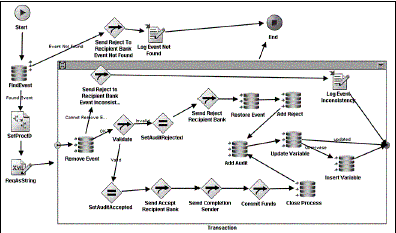
The process begins immediately by querying the PendingEvent table to check that
its event is still pending (FindEvent). If it has already been marked as
completed, the process rejects the request (Send Reject to Recipient Bank Event
Not Found) and quits. Assuming the event is permitted, the process marks the
choice as completed (Remove Event) and validates the request (Validate). If
validation passes, the process, as already discussed, sends an acceptance to
the recipient's bank (Send Accept Recipient Bank) and a completion notifi
cation to the sender (Send Completion Sender), commits the funds (Commit
Funds), and then performs the following table updates:
-
In the Process table, it sets the instance status to COMPLETED (using Close
Process).
-
It adds an entry to the ProcessAudit table (using Add Audit), indicating that
the transfer succeeded.
-
It saves the transfer request message to the ProcessVariable table. If a
previous version of the message is already there, the process overwrites it
(Update Variable); otherwise, it inserts a new message (Insert Variable).
If validation fails, the process sends a rejection message to the recipient bank
(Send Reject Recipient Bank) and makes four table updates:
1. It restores the deferred choice (using Restore Event), setting isDone to
false for each of the three events (Restore Event).
2. It increments the numRejects fi eld in the EXState table (Add Reject).
3. It adds an entry to the ProcessAudit table (using Add Audit), indicating
that the transfer failed.
4. It saves the transfer request message to the ProcessVariable table, using
the same logic as above.
The successful validation path effectively terminates the larger process by
removing all of its pending events. The failed validation path effectively
loops back in the larger process to an earlier point, giving each of the events
another chance to fi re.
The Cancellation Process
T he process to handle cancellation, shown in the next fi gure, starts out much
the same way.
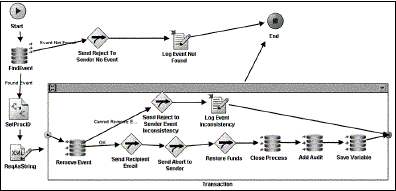
The process fi rst checks that the event is still pending (Find Event), and if
so, disables the deferred choice (Remove Event). The process then notifi es the
sender and the recipient of the cancellation (Send Recipient Email and Send
Abort to Sender), restores the funds (Restore Funds), and update the tables as
follows:
-
It marks the status of the instance as ABORTED (Close Process).
-
It adds an audit entry indicating cancellation (Add Audit).
-
It saves the cancellation event to the ProcessVariable table (Save Variable).
T he Expiration Process
Th e process to handle expired transfers, shown in the next fi gure, is somewhat
different.

The expiration process is not designed to handle the expiry of a single
transfer. Rather, it scans the PendingEvents table for all expired transfers
(Get Expired Transfers), and fi res a cancellation event for each of them. The
outer box labeled For Each Expired is a for loop that, for each record returned
by the query, constructs a cancellation message (Create Cancellation Message)
and launches a cancellation process (Launch Cancellation Process) to handle the
message. It launches the process by sending a message on the JMS queue to which
the routing process listens. The routing process, when it receives the event,
routes it to the cancellation process. Thus, it is the cancellation process
that will disable the deferred choice and abort the instance, not the timer
process.
A Note on Implementation
TIBCO's BusinessWorks is designed for performance, and admittedly our processes
make database updates rather liberally. (The request process has seven updates
in the happy path!) More effi cient alternatives are to fl atten the data model
(so that there are fewer tables to update) or build stored procedures to bundle
updates (resulting in less IO to the database server).
Another option is use TIBCO's proprietary checkpoint mechanism to serialize
process state to the disk. The checkpoint feature is clumsy but is often an
effi cient way to achieve the effect of long-running state in an engine that is
designed for short-running processes. As a proprietary capability, it does not
work as part of a generalized state model, which is why we did not demonstrate
it here.
Fast Short-Running BPEL
We conclude with a discussion of compiled BPEL.
Uses of Short-Running Processes
Hav ing developed an approach to keep SOA processes running for an arbitrarily
long time, we now turn our attention to short-running processes and ask: how
can we make them run as fast as possible? The two most common uses of a
short-running process are:
1. To implement a synchronous web service operation. The process begins with an
input message, runs through a quick burst of logic to process it, sends back
the output message, and completes. The client application blocks for the
duration, as diagram (a) in the next fi gure shows. If the process moves too
slowly, the client will complain about the response time.
2. To perform complex routing for the ESB. As David Chapelle discusses in his
book Enterprise Service Bus (O'Reilly, 2004) , a good ESB can natively perform
basic content-based- and itinerary-based-routing, but it needs orchestration
processes to handle more complex routing patterns. In diagram (b) in the fi
gure, when the ESB receives a message, it passes it to an orchestration process
that proceeds to perform in eight steps a series of transformation and
invocation maneuvers that could never be achieved with the basic branching
capabilities of the ESB. Again, speed is critical. The ESB prefers to get rid
of messages as soon as it gets them. When it delegates work to an orchestration
process, it expects that process to move quickly and lightly.
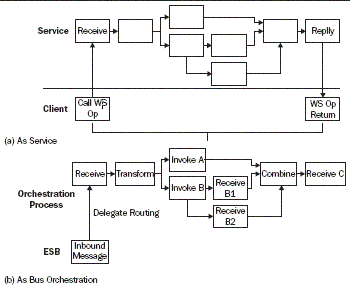
Architecture for Short-Running Processes
In c onsidering a design to optimize the performance of these two cases, we
assume that our stack, like the model stack we discussed in Chapters 1 and 3,
has both an ESB and a process integration layer. All messages in and out of the
stack go through the ESB. The ESB, when it receives an inbound message, routes
it to the process integration engine for processing. The process integration
engine, in turn, routes all outbound messages through the ESB. Further, we
assume that the ESB uses message queues to converse with the process
integration layer. Client applications, on the other hand, typically use web
services to converse with the ESB.
The following fi gure shows how we might enhance this architecture for faster
short-running processes. (The implementation we consider is a Java-based BPEL
process engine.)
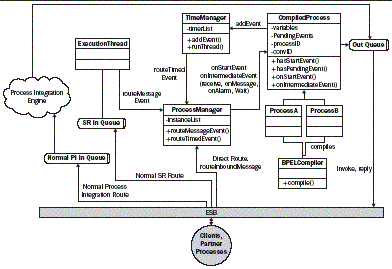
When a client application or partner process calls through the ESB, the ESB
routes the event, based on the event's type, either to the general process
integration engine or to an engine optimized for short-running processes. To
route to the general engine, the ESB places the message on the Normal PI In
Queue. That engine is drawn as a cloud; we are not concerned in this discussion
with its inner workings. To route to the optimized engine, the ESB either
queues the message on SR In Queue or, to reduce latency, directly calls the
short-running engine's main class, ProcessManager. (Direct calls are suitable
for the orchestration routing case described in the previous fi gure; there,
processes run as an extension of the ESB, so it makes sense for the ESB to
invoke them straightaway.) A set of execution threads pulls messages from SR In
Queue and invokes ProcessManager to inject these inbound events to the
processes themselves. The role of ProcessManager is to keep the state of, and
to execute, short-running processes. Each process is represented in compiled
form as a Java class (for example, ProcessA or ProcessB) that inherits from a
base class called CompiledProcess. Compiled classes are generated by a tool
called BPELCompiler, which creates Java code that represents the fl ow of
control specifi ed in the BPEL XML representation of the process.
ProcessManager runs processes by creating and calling the methods of instances
of CompiledProcess-derived classes. It also uses TimeManager to manage timed
events. Processes, whether running on the general engine or on the optimized
engine, send messages to partners by placing messages on the outbound queue Out
Queue, which the ESB picks up and routes to the relevant partner.
A ge n eral process engine is built to handle processes of all durations, long
and short alike, and, with a mandate this extensive, does not handle the
special case of time-critical short-running processes very effectively. There
are three optimizations we require, and we build these into the short-running
engine:
1. Process state is held in memory. Process state is never persisted, even for
processes with intermediate events. Completed process instances are cleaned out
of memory immediately, so as to reduce the memory required.
2. Processes are compiled, not interpreted. That is, the process defi nition is
coded in Java class form, rather than as an XML document. Compilation speeds
the execution time of a burst.
3. The process may defi ne timed events of a very short duration, to the order
of milliseconds. Furthermore, the engine generates a fault when the process
exceeds its SLA. The process may catch the fault or let it bubble up to the
calling application.
The architecture we sketched in this section, as we discover presently, is
designed to meet these requirements.
Example of a Very Fast Process
The n ext fi gure shows a short-running process with multiple bursts that benefi
ts from these optimizations.
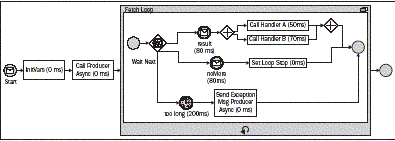
When the process starts, it initializes its variables (InitVars) and
asynchronously invokes a partner process called the Producer (Call Producer
Asynx). It then enters into a loop (FetchLoop) that, on each iteration, waits
for one of the two events from the Producer: result or noMore. If it gets the
result event, it, in parallel, invokes two handler services (Call Handler A and
Call Handler B), and loops back. If it gets the noMore event, the process sets
the loop's continuation fl ag to false (Set Loop Stop). The loop exits, and the
process completes. While it waits for the producer events, the process also
sets a timed event (too long) that fi res if neither event arrives in suffi
cient time. If the timer expires, the process sends an exception message to the
producer (Send Exception Msg Producer Async), and loops back.
The ti ming characteristics are shown in parentheses. The producer, on average,
sends a result or noMore event in 80 milliseconds. The handlers that the
process invokes to handle a result event average 50 milliseconds and 70
milliseconds, but because they run in parallel, their elapsed time is the
greater of these two times, or 70 milliseconds. Thus, an iteration of the loop
with a result event averages roughly 150 milliseconds. An iteration with a
noMore event averages just 80 milliseconds, because the activity Set Loop Stop
runs nearly instantaneously. The cycle time of an instance with one result
iteration and one noMore iteration is just 220 milliseconds. The too long timed
event has a duration of 200 milliseconds, which in itself is rather a small
interval, but is a huge chunk of time compared to the normal cycle time. The
cycle time of an instance whose three intermediate events are result, too long,
and noMore is 420 milliseconds on average. Times this fast cannot be achieved
on a general-purpose engine.
Running the Very Fast Process on the Optimized Engine
The sequence diagram in the following fi gure illustrates how this process runs
on the short-running engine:
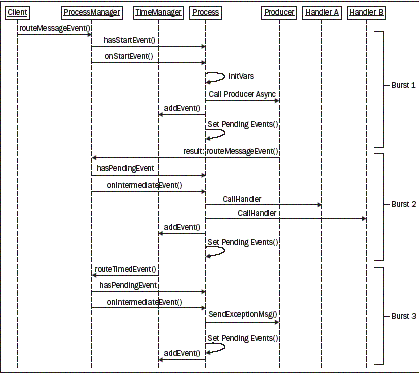
The process starts when client application sends a message intended to trigger
the process' start event. The Pro cessManager receives this event (either as a
direct call or indirectly via an execution thread that monitors the
shortrunning inbound queue) in its routeMessageEvent() method. It then checks
with the process class—shown as Process in the fi gure, a subclass of the
CompiledProcess class we discuss presently—whether it supports the given start
event type (hasStartEvent()), and if so, injects the event into the process
(onStartEvent()). The process, as part of its logic, performs the activities
InitVars and CallProducerAsync and enters the fi rst iteration of the while
loop, in which it records in its data structures that it is now waiting for
three pending events (Set Pending Events). Because one of these events is a
timed event, it also registers that event with the TimeManager (addEvent()).The
fi rst burst is complete.
In the second burst, the producer process responds with a result event (result:
routeMessageEvent()). The ProcessManager checks whether the process instance is
waiting for that event (hasPendingEvent()) and injects it
(onIntermediateEvent()). The process invokes the two handlers (that is, it
invokes CallHandler on HandlerA and HandlerB), completing the fi rst iteration
of the loop. It now loops back, resets the pending events (Set Pending Events),
and registers a new timed event (addEvent()). The second burst is complete.
Assuming the producer does not respond in suffi cient time, the timer expires,
and the TimeManager which checks for expired events on its own thread notifi es
the Process Manager (routeTimedEvent()). ProcessManager gives the event to the
process (calling hasPendingEvent() to confi rm that the process is waiting for
it and onIntermediateEvent() to inject it), and the process in turn performs
the SendExceptionMsg activity, completing the second iteration of the loop. The
next iteration starts, and the process resets its pending events. The third
burst is complete, and we leave it there.
Summary
SOA processes have both active and passive activities. Active activities include
calls to systems and services, data manipulations and transformations, and
scripts or inline code snippets. Passive activities are events. When performing
active activities, the process is actively performing work, tying up the
process engine. Events put the process into an idle wait state.
An event can occur at the beginning of the process or in the middle. Every SOA
process starts with an event. An event in the middle is called an intermediate
event, and not every SOA process has one. The segment of a process between two
events is called a burst; in a burst, the process performs active activities.
Processes are classifi ed by duration as short-running, long-running, or
mid-running.
Short-running processes span no more than a few seconds. Many short-running
processes are a single burst, but some have intermediate events, which break
the process into multiple bursts. Languages that support short-running
processes include TIBCO's BusinessWorks and BEA's Weblogic Integration.
Long-running processes run longer—often days, weeks, months, or years— than the
uptime of the process engine on which they run. Most of the time is spent
waiting on intermediate events; the bursts themselves are quick. The engine
persists the state of such processes to a database to survive a restart.
Languages that support long-running processes include BPEL and Weblogic
Integration.
Mid-running processes run for about the duration of a phone call in a call
center. In call center usage, processes are structured as question-and-answer
conversations between agent and customer. Bursts process the previous answer
and prepare the next question; intermediate events wait for the customer's next
answer. The engine keeps process state in memory. If the engine goes down,
in-fl ight instances are lost. Chordiant's Foundation Server is an example of
this sort of implementation.
Process data models include process metadata (information about the types of
processes currently deployed), instance data (the status of live instances of
processes), and pending events (and how to correlate them with instances). We
studied the data models in Oracle's BPEL Process Manager and BEA's Weblogic
Integration, and developed our own model that generalizes these. We used this
model to build a use case that requires a long-running process (email funds
transfer) from several short-running processes in TIBCO's BusinessWorks.
We concluded by designing a process engine optimized for short-running
processes. The design is able to run short-running processes faster than a
typical process engine because process state is held in memory (never
persisted), processes are compiled rather than interpreted, and the process may
defi ne timed events of a very short duration. Further, the engine generates a
fault when the process exceeds its SLA; the process may catch the fault or let
it bubble up to the caller.
Also see
What is Service-Oriented Architecture? Why SOA? Challenges faced in SOA
adoption. What is SOA governance? What are its functions? Business Benefits of
Service-Oriented Architecture. IT Benefits of Service-Oriented
Architecture........
Here, we will be exploring the Service Engine. Services in OFBiz operate in a
Service Oriented Architecture (SOA). These services not only have the ability
to invoke other services internaBlly, but can also be 'opened up' and invoked
by remote applications using, amongst other methods, the widely adopted
messaging protocol SOAP.
Concurrency is the system's ability to act with several requests simultaneously,
such a way that threads don't corrupt the state of objects when they gain
access at the same time.........
To get better results in terms of speed and resources used, it's suggested to
use a cache. We can store in it the results corresponding to the methods'
invocations as key-value pairs: method and arguments as key and return object
as value................
Once a user is authenticated and has roles, he or she can work on the
application and perform the actions permitted by an access control list, which
according to the user's roles allows certain operations................
Explain
an object, class and Method.
An object is an entity that keeps together state and behaviors.
For instance, a car encapsulates state such as red color, 900 cc etc and
behaviors as 'Start', 'Stop' etc., so does an object...............
Define
Encapsulation and Information Hiding in OOP.
Encapsulation means keeping actions and attributes together under a single unit.
This can also be understood using a motor bike example. A bike has actions such
as 'switch on light', 'horn' etc. and attributes such specific color, size,
weight etc..............
Explain Inheritance
and Polymorphism in OOP.
Inheritance concept in OOP allows us to create a new class using an existing
one. It also allows the new class to add its own functionality............
What
are the advantages of OOP?
It presents a simple, clear and easy to maintain structure. It enhances program
modularity since each object exists independently............
|